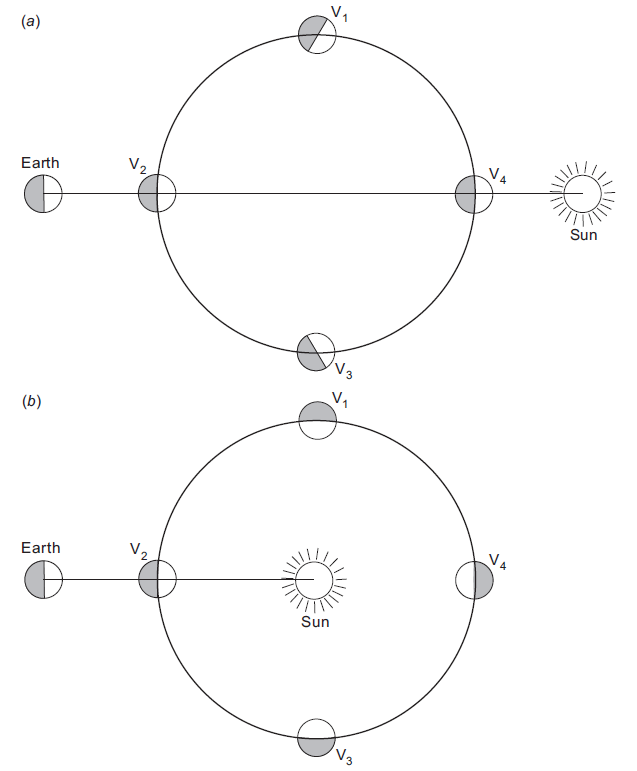


 الفيزياء الكلاسيكية
الفيزياء الكلاسيكية
 الكهربائية والمغناطيسية
الكهربائية والمغناطيسية
 علم البصريات
علم البصريات
 الفيزياء الحديثة
الفيزياء الحديثة
 النظرية النسبية
النظرية النسبية
 الفيزياء النووية
الفيزياء النووية
 فيزياء الحالة الصلبة
فيزياء الحالة الصلبة
 الليزر
الليزر
 علم الفلك
علم الفلك
 المجموعة الشمسية
المجموعة الشمسية
 الطاقة البديلة
الطاقة البديلة
 الفيزياء والعلوم الأخرى
الفيزياء والعلوم الأخرى
 مواضيع عامة في الفيزياء
مواضيع عامة في الفيزياء|
Read More
Date: 24-2-2016
Date: 21-8-2020
Date: 6-2-2017
|
The astronomical discoveries of Galileo
In 1609, Galileo built his first telescope and initiated a revolution in astronomy. Among his discoveries with that telescope and improved instruments he constructed in later years were the following:
• He saw the Milky Way resolved into stars.
• He discovered sunspots. From their movements he measured the period of rotation of the Sun to be close to 27 days.
• When he turned his telescopes to the Moon he observed mountains, craters and plains. He also measured the Moon’s apparent wobble on its axis, enabling us to see more than half of the lunar surface.
• The planets showed disks of appreciable size.
• Venus showed phases like the Moon.
• He discovered Jupiter had four moons of its own.
• Saturn was seen to have two blurred appendages which Galileo was quite unable to interpret.
• The Pleiades, the star group containing six or seven stars as seen with the unaided eye, had at least 36 stars when viewed with the telescope.
• The three nebulous stars in Praesepe became 40 in number.
Two discoveries, in particular, gave Galileo tremendous satisfaction, enabling him to dismiss the Ptolemaic System in favour of the Copernican one.
To those who said that the Moon would be left behind if the Earth moved, he could point to Jupiter’s satellites. Even in the Ptolemaic System, Jupiter moved, yet its four moons were not left behind.
The phases of Venus were even more convincing as an argument in favour of the heliocentric theory.
Undoubtedly, the planets shone by the reflected light of the Sun. Their phases, as observed from the Earth, would depend upon whether or not the Earth was the centre of the Solar System.
In the Ptolemaic System (figure 1(a)), Venus could never lie on the other side of the Sun from the Earth (in superior conjunction as we would now put it). In the telescope, it would always remain crescent in phase, and its apparent angular size would not change greatly. In the Copernican System (figure 1(b)), Venus could be in superior conjunction, V4. Before it became lost in the Sun’s glare, it would show an almost full phase, rather like full Moon. When it reappeared some days later on the other side of the Sun, having passed behind the Sun, its phase would again be almost full but would be waning, instead of waxing. As the planet moved round in its orbit from V4 to V2 via V1, not only would the phase wane until a thin crescent was seen just before V2 but

Figure 1. The phases of Venus (a) the Ptolemaic System (b) the Copernican System.
its apparent size would increase markedly as it approached the Earth. After it passed V2 and entered the other half of its synodic journey, its size would decrease and its phase wax from a thin crescent to almost full Venus once more. Observations of Venus by Galileo showed that Venus changed phase and angular size exactly in accordance with the Copernican System’s predictions.



|
|
|
|
لخفض ضغط الدم.. دراسة تحدد "تمارين مهمة"
|
|
|
|
|
|
|
طال انتظارها.. ميزة جديدة من "واتساب" تعزز الخصوصية
|
|
|
|
|
|
|
مشاتل الكفيل تزيّن مجمّع أبي الفضل العبّاس (عليه السلام) بالورد استعدادًا لحفل التخرج المركزي
|
|
|